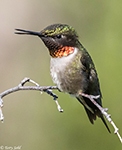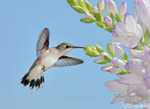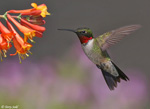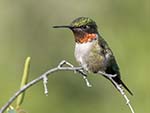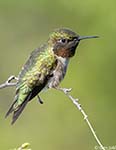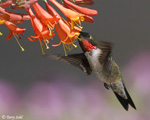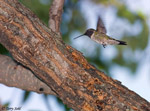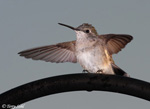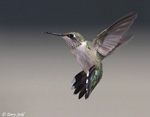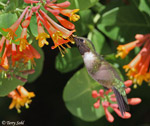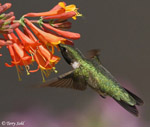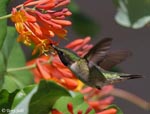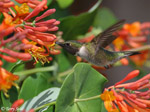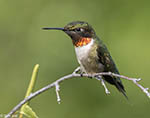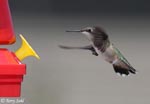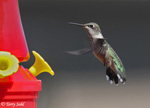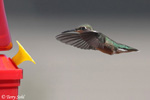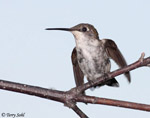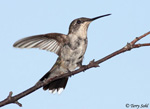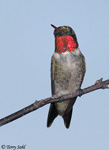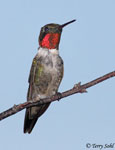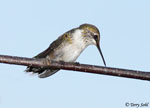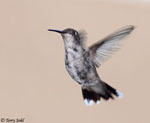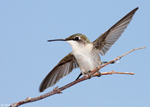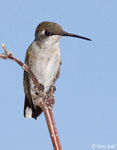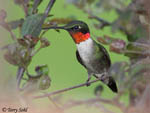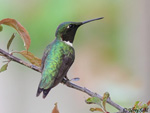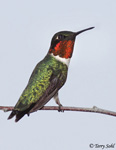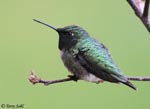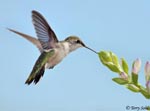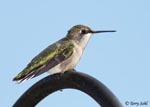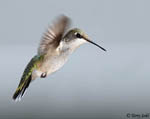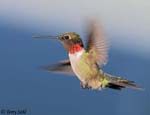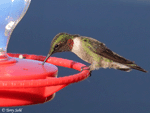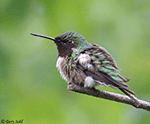| Length: 3.5 to 3.75 inches | Wingspan: 4.25 to 4.50 inches | Seasonality: Summer/Migrant |
| ID Keys: Deep red throat (male), white chest, green sides, black slightly forked tail | ||
 The
Ruby-throated Hummingbird is the only hummingbird commonly found in the eastern
United States, and is the only hummingbird commonly found in the eastern half of
South Dakota. They have only rarely been found breeding in South Dakota,
but given their presence throughout the summer (including presence of young
birds after fledging), especially in the extreme eastern portion of the state,
they are no-doubt consistent breeders in the state. The Ruby-throated
Hummingbird migrates non-stop across the Gulf of Mexico to its normal wintering
grounds in Central America. A male is pictured in the photo on the right,
with its deep ruby-throat giving the species its name.
The
Ruby-throated Hummingbird is the only hummingbird commonly found in the eastern
United States, and is the only hummingbird commonly found in the eastern half of
South Dakota. They have only rarely been found breeding in South Dakota,
but given their presence throughout the summer (including presence of young
birds after fledging), especially in the extreme eastern portion of the state,
they are no-doubt consistent breeders in the state. The Ruby-throated
Hummingbird migrates non-stop across the Gulf of Mexico to its normal wintering
grounds in Central America. A male is pictured in the photo on the right,
with its deep ruby-throat giving the species its name.
Habitat:
Can be found in a wide variety of semi-open habitats with suitable feeding locations, including riparian areas, shelterbelts, suburban parks and yards, and forest edges and clearings.
Diet:
Feeds primarily on nectar from flowers, seemingly with a preference for reddish or orange-colored flowers. Also will take a variety of small insects and spiders. They occasionally have been found feeding on the sap wells created by the various species of sapsuckers (see photo #7 at the bottom of the page).
Behavior:
Other than during mating season, Ruby-throated Hummingbirds are often not very social. Although numbers may be found in the same general area, individual birds will often vigorously defend prime feeding patches. Extremely active during daylight hours, their day primarily consists of feeding, with short periods of rest in between.
Nesting:
June through August. The nest of a Ruby-throated Hummingbird is a small cup built of fibrous plant material and plant down, cemented together with spider webs. The outside is often covered with moss, lichen, or other material. The female lays 2 eggs, and she alone incubates them. After the eggs hatch, the female alone feeds the young. The young fledge after about 3 weeks.
Song:
A multi-note series of musical chip notes (often of varying length) is given in flight, or when males challenge each other's territories. A modest wing-beat sound is also sometimes heard. Click here to hear a short series of Ruby-throated Hummingbird calls and wing-beat sounds1.
Migration:
Summers throughout the eastern half of the U.S. and extreme southern Canada. Primarily winters in Mexico and Central America.
Interactive eBird Map:
Click here to access an interactive eBird map of Ruby-throated Hummingbird sightings
Similar Species:
Broad-tailed Hummingbird, Black-chinned Hummingbird. The Broad-tailed Hummingbird is the most similar in appearance, sharing the overall plumage pattern. Range however, helps to easily differentiate between the two species, as Ruby-throated Hummingbirds are found in eastern North America, while Broad-tailed Hummingbirds are found in the West, with no usual overlap. In the case of vagrant birds, the color of the male's gorget differentiates the species, with Ruby-throated Hummingbirds having a definitive reddish tone to the gorget, while Broad-tailed Hummingbirds have more of a magenta or bright pinkish tone.
Feeders:
Will attend feeders for sugar water. Will attend flower gardens for nectar.
South Dakota "HotSpot":
The Ruby-throated Hummingbird is one species for which a "hotspot" can be created, and rather quickly. Having nearby nesting habitat clearly helps, but in migration and for birds who have completed breeding, establishing rich, diverse sources of food in your own yard can be extremely successful in attracting Ruby-throated Hummingbirds within their normal range. When we built our house in the fall of 2005, and by the following summer, a mere 7 months after moving in, hummingbirds were already appearing regularly in our newly landscaped yard. Honeysuckle, weigela, trumpet vine, and other plants placed in the landscape, along with a hummingbird feeder, attracted the birds almost immediately once the newly placed landscape plants blossomed that first summer. They're now extremely regular visitors, arriving in our yard every year around May 7, with the last stragglers departing the 2nd or 3rd week of September.
Conservation Status:
They are found over a wide geographic area, are common in many parts of their range, and appear to be increasing in number. Data from Breeding Bird Survey records show an increase of over 25% per decade for the last 40 years, resulting in a total population increase of over 150%. Increased usage of flowering plants in urban and suburban landscaping may partially be behind the increase. The IUCN lists the Ruby-throated Hummingbird as a species of "Least Concern".
Further Information:
- Patuxent Bird Identification InfoCenter, Ruby-throated Hummingbird
- WhatBird - Ruby-throated Hummingbird
- Audubon Guide - Ruby-throated Hummingbird
Photo Information:
June 10th, 2008 - Our house in Brandon, South Dakota - Terry Sohl
Additional Photos:
Click on the image chips or text links below for additional, higher-resolution Ruby-throated Hummingbird photos.
Audio File Credits:
1Russ Wigh, XC195616. Accessible at www.xeno-canto.org/195616
| Click on the map below for a higher-resolution view |
 |
| South Dakota Status: Uncommon migrant and summer resident in the eastern part of the state. Rare visitor in the western part of the state. |
Additional Ruby-throated Hummingbird Photos
Click for a higher-resolution version of these photos
